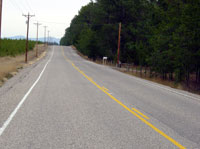
Full-depth reclamation (FDR) of failed asphalt pavements using cement provides many advantages over other methods of road rehabilitation, and Spokane County in Northeastern Washington State has been using the advantages to full benefit. The county first used FDR with cement in the late 1990s, and is currently maintaining a steady program of 5 to 6 miles of full-depth reclamation construction per year. According to County Engineer Ross Kelley, their reclamation program allows them to gradually improve the quality of their road network at a very reasonable cost.
Spokane County roadway
Building All-Weather Roads with Cement
Being located in the foothills of the Rocky Mountains, and only 100 miles from the Canadian border, Spokane County experiences the type of weather conditions that can cause serious pavement damage. In the spring, the warmer weather brings melting conditions that can cause serious road deterioration. This brings the need for truck restrictions on rural roads that are not built to handle heavy loads during the spring conditions. These road restrictions cause interruptions for commerce and industry that can affect the local economy.
The FDR process results in a reconstructed cement-treated base, which greatly increases the strength of the pavement structure, and does not weaken during seasonal changes. In areas with frost conditions, the cement-treated base will not experience moisture movement, so frost is not a problem in the base. For frost in the subgrade, the stabilized base tends to raise and lower as a platform, reducing the effects of frost heaves. Spokane County has not noticed any frost problems with roads that have been reconstructed with the full-depth reclamation process. In fact, they are programming the FDR work in order to build routes of cement stabilized all-weather roads that will not have to undergo the spring load restrictions.
Effective Pavement Design
The county developed a very effective pavement design that incorporates 8 – 10 inches of cement-treated base. The typical design for the base is 400 pound per square inch (psi) compressive strength in seven days, usually requiring about 4 percent cement. In situations where the soil conditions are poor, the county prefers to keep the strength of the base unchanged, and increase the thickness from 8 -- 10 inches.
To complete the pavement structure, a 1 – 3 inch layer of crushed stone is used on top of the base for leveling and as a mat for the surface, which consists of a “triple-shot” bituminous surface treatment. This surface treatment is constructed by placing three light bituminous surface treatments. The leveling course also acts as an effective “stress relief” layer, to prevent reflective cracks in the pavement surface. The county is currently evaluating the thickness of the leveling course, and recently built some sections with 1, 2, and 3 inch thicknesses and will monitor their performance. They are also considering the use of a paved asphalt concrete surface (instead of the triple surface treatment) for roads that carry high levels of traffic.
Preserving the Road Template
Increasing the strength of the pavement structure using conventional methods (such as using an additional 8 – 10 inches of stone base) requires changing the road cross-section, because the additional road elevation must be accompanied by building up the shoulder slope. This can be expensive because of the additional material and construction required to change the cross-section. Using FDR provides the capability of “building the pavement down”; strengthening the existing pavement using the materials already there, and eliminating the need for changing the road elevation.
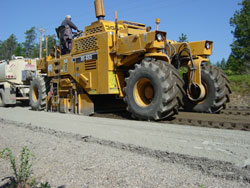
Blending materials
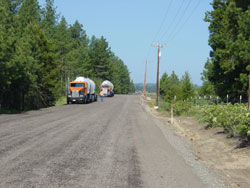
Cement arrives on project
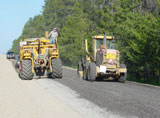
Pulverizing and shaping roadway
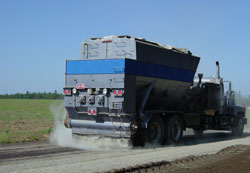
Applying dry cement
Partnering the Construction Process
On all of their full-depth reclamation projects, Spokane County has been involved as a partner in the construction process, thereby reducing costs and having more control over the final product. The county will typically contract out the pulverization of the existing pavement, placement of cement, and mixing of the base materials, and will complete the grading, compaction, and surfacing with county forces.
The all-inclusive cost (including contingencies and engineering) of a typical FDR project in Spokane County is around $140,000 per mile, including the surfacing. The portion of the project spent on just the FDR process (pulverization and cement stabilization to build the cement-treated base) is approximately one-fourth to one-third of the total, typically in the range of $3 to $4 per square yard. “We’re real happy with the results of the process” said Howard Hamby, pavement manager for Spokane County’s Public Works Department. The county goes through a thorough evaluation of the costs of pavement design alternatives, and feels that the substantial increase in pavement strength from FDR with cement will lead to much better long-term pavement performance.